- Joined
- Jul 1, 2014
- Messages
- 3,722 (0.95/day)
I know what you are thinking—this isn't the typical news content we see on TechPowerUp. Yes, we do cover audio products with plenty of reviews here, including Audeze planar magnetic headphones. When Audeze mentioned there's a whole different thing coming up, and that it involves carbon nanotubes (CNTs), I was quite intrigued. Some of you may have picked it up by now, but all the neat toys I have access to and used in several reviews come because I am a research scientist by profession, with a specialization in carbon nanomaterials including CNTs. So this news post is about my attempt to help explain why the Audeze technology is such a big deal. This is not a review of the actual devices and neither is it a sponsored post, or even solicited by Audeze. It is purely me geeking out about a fairly novel use of CNTs in the audio world, especially when there have been CNT coatings on a few dynamic drivers before but barely put to the potential capable until now.
See, the whole reason the Audeze CRBN (Carbon, get it?) even came about is because an indirect research colleague of mine, Prof. Mark Cohen from the University of California, Los Angeles as well as his startup company SMRT Image, saw a need for a more calming influence for patients undergoing fMRI imaging, as well as better means for the technicians to communicate with said patients while they are inside an operating MRI machine. If you have ever been inside one, you would know that thing gets real loud with magnetic coils rapidly going around and clacking noises galore. Audeze is also based in California, and multiple years of research led to the development of the Audeze CRBN—starting off for medical applications and then coming out also as a high-end retail headphones experience based on the knowledge and IP gained in the process. Read past the break for more on the science and tech, if this is of interest to you!
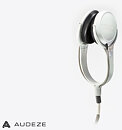
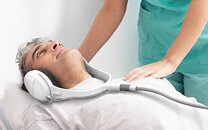
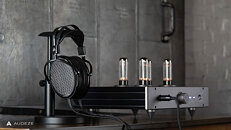

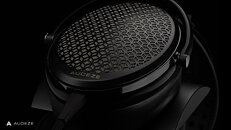
At this point, a logical question would be what happens if the sounds are loud inside an MRI machine? Can't the patient simply wear ear protection such as ear defenders that have been successfully used in other loud use cases, including construction? Typical noises inside an MRI machine can get as loud as 120 dB, which is similar to having a jackhammer going next to you. More often than not, there is also a head constraint device used to mitigate motion which in turn does not allow for larger ear defenders to be used. Any magnetic/ferromagnetic metal is also a big no-no since the magnetic coils of the MRI can rip them out owing to the strong magnetic field. This is why piercings are to be removed prior to imaging, else you might end up replicating one of the few good scenes from Terminator Genisys. Small ear plugs only go so far too in terms of isolation provided, especially in the absence of a custom fit. In fact, even some metals can generate Eddy currents that can impact imaging inside. When the slightest of motion can result in poor imaging, it is important to have good noise isolation. At the same time, having a clear line of communication with the technician is also critical, which makes this harder to achieve.
Current solutions tend to go the way of silicone earphones without a lot of metal in them, which means the actual drivers have to be configured in a challenging manner. Having aided with some MRI research myself, albeit for different purposes, I was thus curious about what the answer was long-term for patients who get stress and anxiety over a scan to begin with, let alone any effects of claustrophobia and phonobia. Active noise cancellation seems like the way to go, but once again the actual drivers for the headphones are a challenge since you can't use wireless tech here and specialized MRI noise cancellation is either $$$$$$ in the form of external drivers with long, shielded cables or not very effective. There is thus a need for conductive driver materials which are not metallic, or at least non-magnetic and unaffected by the magnetic flux generated by the MRI. Planar magnetic headphones are clearly not the answer either, since they are driver by high magnetic flux internally so any external magnetic field can cause all sorts of havoc.
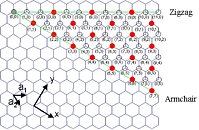
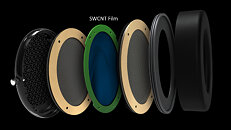
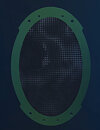

Enter carbon nanotubes, and more specifically single-walled carbon nanotubes at that. A single wall carbon nanotube (SWCNT) is a carbon allotrope envisioned by rolling up a graphene sheet, which in turn is a single layer of graphite that itself can be visualized as a flat sheet of carbon atoms. The nature of rolling said sheet dictates what is called the chirality of the SWCNT, with the maximum possible chiralities and chiral angle (of rolling) between 0° and 30° relative to the plane, based on thermodynamics allowing only those to exist in a stable state. One of these extremities (armchair) is the best possible electrical conductor, and the other extremity (zigzag) a semiconductor. Anywhere in between and you get semi-metals and metals in that you have electron transfer but it is still carbon on the macroscale. See where I am getting at? If the diaphragm of a typical headphone driver setup were to be made of SWCNTs, then that would solve the big issue from above. The next challenges involve (a) how to get the SWCNTs as a diaphragm/transducer, and (b) how to actually drive it. Audeze and its collaborator ended up going with a suspension of SWCNTs in a polyimide, which is one of the several options available. I might have gone another route depending on the suspension thickness and desired qualities, but here we are anyway. This suspension allows a stable film to be made that has the SWCNTs inside, ideally uniformly to thus also have uniform electrical conductivity.
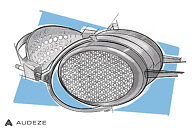
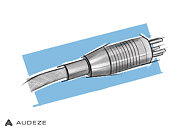
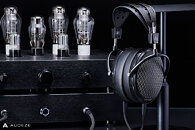
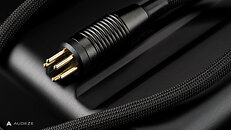
The second challenge was seemingly addressed by using these ultra-thin SWCNT diaphragms as a conductive media for electrostatic charge, which forms the basis for electrostatic headphones. I don't have a lot of experience with this class of headphones yet, but I understand the science behind how they work in needing a high driving potential (think 800-1000 Vrms) to generate the electrostatic field that in turn vibrates the diaphragm to generate sound waves. This decoupling mechanism of driving the headphones without the need for classically metallic drivers should help also place active noise cancelling materials along the way, which seems to have been done with the MRI imaging version of the Audeze CRBN that I understand will be sold through SMRT Image directly in Q4 2021.
The other end of this technology comes with the retail version, just referred to as Audeze CRBN with a rated 100 pF electrostatic capacitance. As it turns out, having the ultra-thin diaphragm allows for more accuracy in the reproduced sound signature, or so Audeze claims anyway at this point without much independent testing having been done aside from a few music recording artists sharing their opinions. It does have some logic behind it, since the way I see increased audio fidelity and resolution to be is to have effectively an ultra-thin diaphragm with nothing in front of it, and as uniform a force as possible pushing and pulling it back as needed. Planar magnetic drivers come close, but ribbon drivers as seen in the recently launched and sold-out Audeze LCD-R are a further step in that direction. With these electrostatic drivers, Audeze and everyone else in the game aims to go even beyond in the race for extreme neutrality and accuracy, but with the added benefit of not weighing as much as the typical full-size planar magnetic drivers either. Take that for what you will, but music monitoring is going to be a key use case here if so. If you have $4500 to spend on a pair of the Audeze CRBN, and more for a standard electrostatic amplifier using the 5-pin connector and rated for 570 V, then you can try this out for yourself when orders open up on the Audeze website as well as some retailers. Once again I have to stress that I do not have any idea how these sound at this point or whether they merit the money. Hopefully some of you found this interesting, and feel free to share your thoughts as comments below.
View at TechPowerUp Main Site
See, the whole reason the Audeze CRBN (Carbon, get it?) even came about is because an indirect research colleague of mine, Prof. Mark Cohen from the University of California, Los Angeles as well as his startup company SMRT Image, saw a need for a more calming influence for patients undergoing fMRI imaging, as well as better means for the technicians to communicate with said patients while they are inside an operating MRI machine. If you have ever been inside one, you would know that thing gets real loud with magnetic coils rapidly going around and clacking noises galore. Audeze is also based in California, and multiple years of research led to the development of the Audeze CRBN—starting off for medical applications and then coming out also as a high-end retail headphones experience based on the knowledge and IP gained in the process. Read past the break for more on the science and tech, if this is of interest to you!





At this point, a logical question would be what happens if the sounds are loud inside an MRI machine? Can't the patient simply wear ear protection such as ear defenders that have been successfully used in other loud use cases, including construction? Typical noises inside an MRI machine can get as loud as 120 dB, which is similar to having a jackhammer going next to you. More often than not, there is also a head constraint device used to mitigate motion which in turn does not allow for larger ear defenders to be used. Any magnetic/ferromagnetic metal is also a big no-no since the magnetic coils of the MRI can rip them out owing to the strong magnetic field. This is why piercings are to be removed prior to imaging, else you might end up replicating one of the few good scenes from Terminator Genisys. Small ear plugs only go so far too in terms of isolation provided, especially in the absence of a custom fit. In fact, even some metals can generate Eddy currents that can impact imaging inside. When the slightest of motion can result in poor imaging, it is important to have good noise isolation. At the same time, having a clear line of communication with the technician is also critical, which makes this harder to achieve.
Current solutions tend to go the way of silicone earphones without a lot of metal in them, which means the actual drivers have to be configured in a challenging manner. Having aided with some MRI research myself, albeit for different purposes, I was thus curious about what the answer was long-term for patients who get stress and anxiety over a scan to begin with, let alone any effects of claustrophobia and phonobia. Active noise cancellation seems like the way to go, but once again the actual drivers for the headphones are a challenge since you can't use wireless tech here and specialized MRI noise cancellation is either $$$$$$ in the form of external drivers with long, shielded cables or not very effective. There is thus a need for conductive driver materials which are not metallic, or at least non-magnetic and unaffected by the magnetic flux generated by the MRI. Planar magnetic headphones are clearly not the answer either, since they are driver by high magnetic flux internally so any external magnetic field can cause all sorts of havoc.




Enter carbon nanotubes, and more specifically single-walled carbon nanotubes at that. A single wall carbon nanotube (SWCNT) is a carbon allotrope envisioned by rolling up a graphene sheet, which in turn is a single layer of graphite that itself can be visualized as a flat sheet of carbon atoms. The nature of rolling said sheet dictates what is called the chirality of the SWCNT, with the maximum possible chiralities and chiral angle (of rolling) between 0° and 30° relative to the plane, based on thermodynamics allowing only those to exist in a stable state. One of these extremities (armchair) is the best possible electrical conductor, and the other extremity (zigzag) a semiconductor. Anywhere in between and you get semi-metals and metals in that you have electron transfer but it is still carbon on the macroscale. See where I am getting at? If the diaphragm of a typical headphone driver setup were to be made of SWCNTs, then that would solve the big issue from above. The next challenges involve (a) how to get the SWCNTs as a diaphragm/transducer, and (b) how to actually drive it. Audeze and its collaborator ended up going with a suspension of SWCNTs in a polyimide, which is one of the several options available. I might have gone another route depending on the suspension thickness and desired qualities, but here we are anyway. This suspension allows a stable film to be made that has the SWCNTs inside, ideally uniformly to thus also have uniform electrical conductivity.




The second challenge was seemingly addressed by using these ultra-thin SWCNT diaphragms as a conductive media for electrostatic charge, which forms the basis for electrostatic headphones. I don't have a lot of experience with this class of headphones yet, but I understand the science behind how they work in needing a high driving potential (think 800-1000 Vrms) to generate the electrostatic field that in turn vibrates the diaphragm to generate sound waves. This decoupling mechanism of driving the headphones without the need for classically metallic drivers should help also place active noise cancelling materials along the way, which seems to have been done with the MRI imaging version of the Audeze CRBN that I understand will be sold through SMRT Image directly in Q4 2021.
The other end of this technology comes with the retail version, just referred to as Audeze CRBN with a rated 100 pF electrostatic capacitance. As it turns out, having the ultra-thin diaphragm allows for more accuracy in the reproduced sound signature, or so Audeze claims anyway at this point without much independent testing having been done aside from a few music recording artists sharing their opinions. It does have some logic behind it, since the way I see increased audio fidelity and resolution to be is to have effectively an ultra-thin diaphragm with nothing in front of it, and as uniform a force as possible pushing and pulling it back as needed. Planar magnetic drivers come close, but ribbon drivers as seen in the recently launched and sold-out Audeze LCD-R are a further step in that direction. With these electrostatic drivers, Audeze and everyone else in the game aims to go even beyond in the race for extreme neutrality and accuracy, but with the added benefit of not weighing as much as the typical full-size planar magnetic drivers either. Take that for what you will, but music monitoring is going to be a key use case here if so. If you have $4500 to spend on a pair of the Audeze CRBN, and more for a standard electrostatic amplifier using the 5-pin connector and rated for 570 V, then you can try this out for yourself when orders open up on the Audeze website as well as some retailers. Once again I have to stress that I do not have any idea how these sound at this point or whether they merit the money. Hopefully some of you found this interesting, and feel free to share your thoughts as comments below.
View at TechPowerUp Main Site







